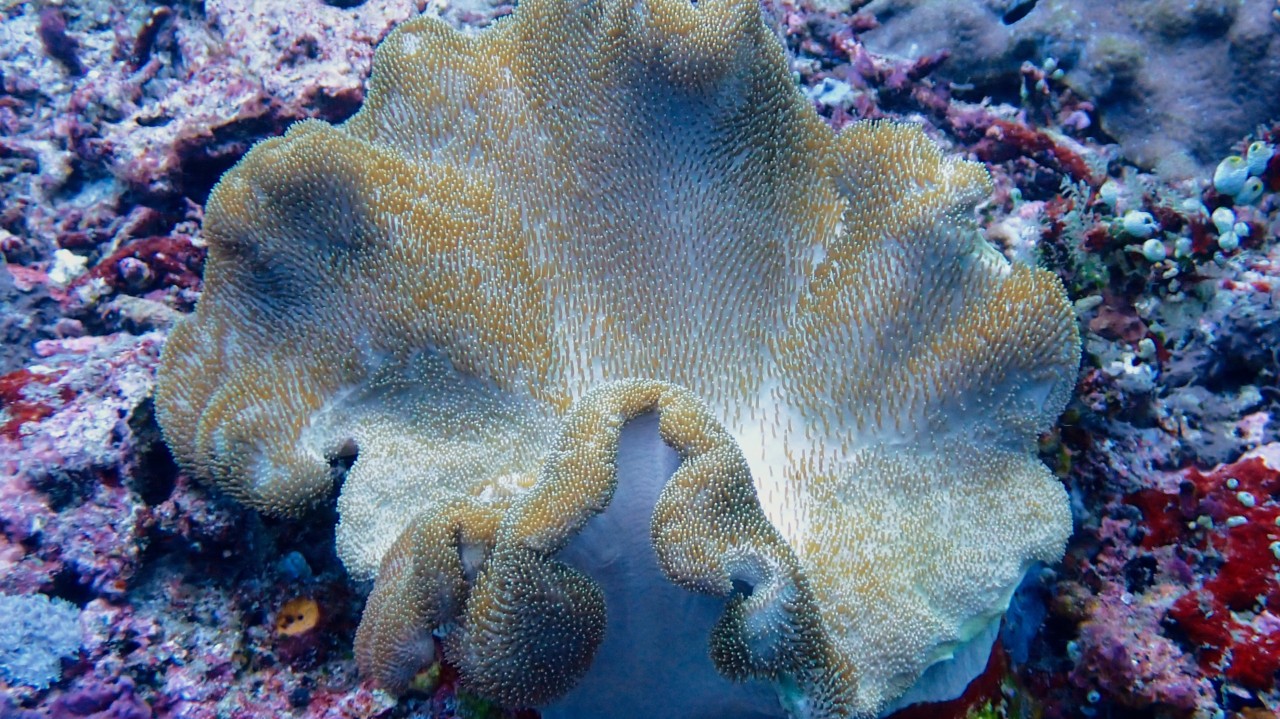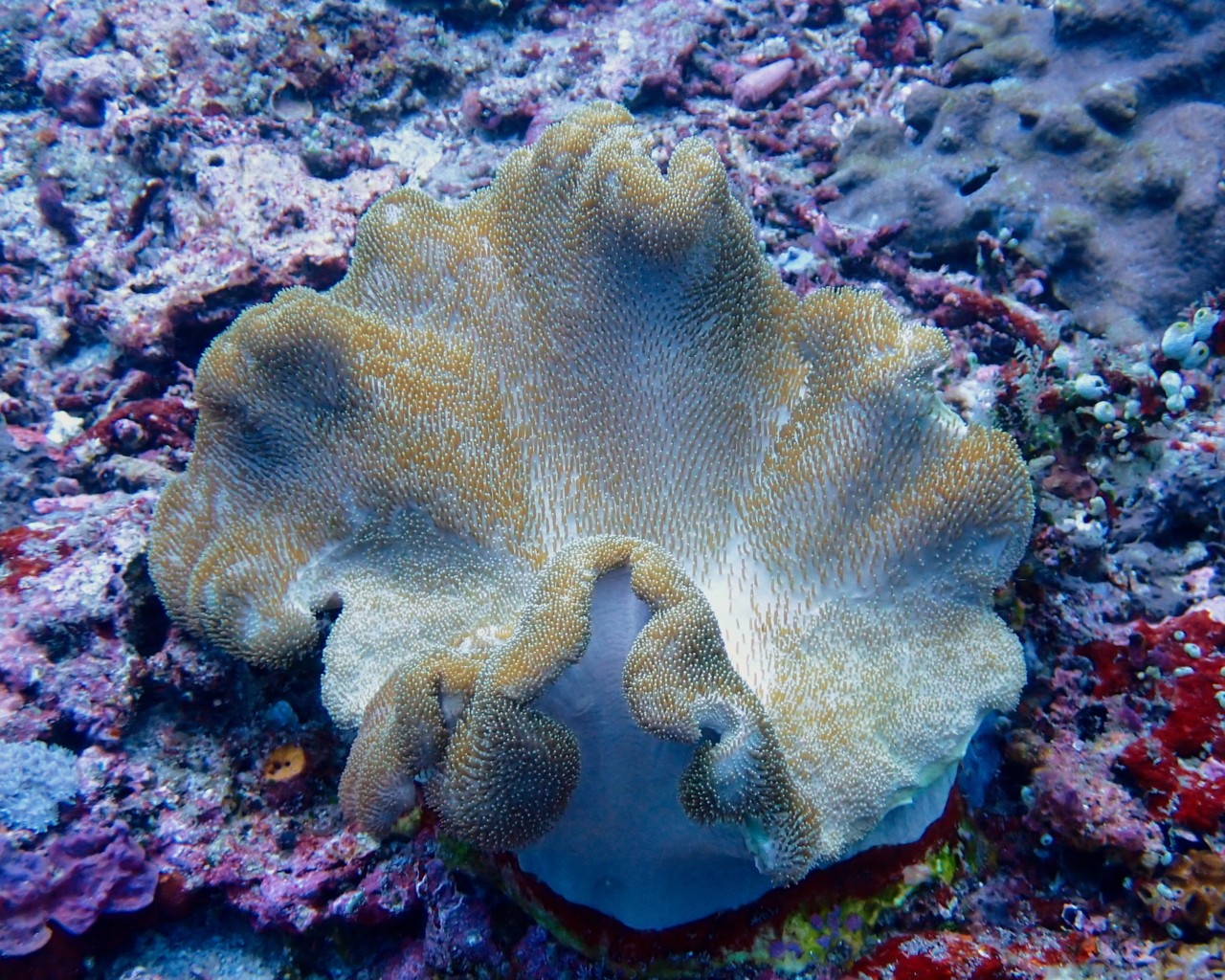

Photograph by Rachele Daminelli / Connected Archives
Words by Becca Warner
Below the surface of the sea, on a reef just a couple of meters beneath its crashing waves, the sounds of life abound. Shrimps click their claws, creating a crackling backdrop to the squeals and whoops of fish. Some creatures hum and thrum, others grunt and growl. They are communicating, catching lunch, or calling a mate.
These underwater sounds are muffled to the human ear. But a hydrophone—specialized equipment that picks up sound vibrations in water—reveals a rich variety of individual rhythms and tones. It is a soundscape that Tim Lamont, a marine biologist at Lancaster Environment Centre, has become familiar with. “It’s like a sort of joyful chaos,” he says.
So long as the reef is healthy, that is. “Healthy reefs are louder [than degraded ones],” Lamont explains. “There’s more going on, there’s more sound types, and there’s more variation throughout the day. And fish can tell the difference.”
Lamont’s research has found that, when the sound of a healthy reef is played through speakers on a patch of dead coral reef, fish flock to it. Twice as many fish, with 50% greater species variation, swim to and settle on that patch compared to a dead reef patch where these sounds are not played. His findings are part of a growing body of research showing that simply playing the sounds of a healthy ecosystem can bring a degraded one to life.
This method is known as “acoustic enrichment.” Earlier this year, researchers at the Woods Hole Oceanographic Institution investigated whether acoustic enrichment could help rebuild the reef itself: would coral larvae move towards the sounds of a healthy reef? The answer was yes. When the sound of a healthy coral reef was played to them through speakers, coral larvae settled at an average rate 1.7 times—and up to a maximum of seven times—higher than when no such sound was played. Where these larvae settle, a barren reef is replenished or a new one can form and grow.
Nature’s own sounds, then, could be a powerful tool in the race to restore natural habitats—especially coral reefs, which have suffered a devastating 50% loss since the 1950s. “Often we’re building new wild habitats, and hoping that wild animals come and settle in and make it a fully functioning ecosystem,” Lamont says. “If we can speed up the rate at which they’ll settle into that habitat, then the process of holistic restoration will, in theory, happen faster.”
It’s worth noting that some of these findings are confined to a laboratory setting. The strong currents of the open sea could prevent coral larvae—who are not strong swimmers—from following the enticing tune of underwater life. But in a world where up to 90% of coral reefs are predicted to disappear by 2040, any possibility for restoration seems worth our attention. Following Lamont’s research on fish, seabed speakers have been installed in the Caribbean and off the Australian coast to see if the effects can be replicated in the wild.
Fish and corals are not the first species that have been lured by playback of their own sounds. Scientists have used these methods to attract seabirds to breeding sites, help warblers mate, and get frogs safely across the road.
Acoustic enrichment is showing early signs of success. But its effectiveness brings with it important ethical considerations.
Acoustic enrichment is showing early signs of success. But its effectiveness brings with it important ethical considerations. Who gets to decide which animals are attracted where—and by what sounds? And what might happen when they do?
Dr Pralle Kriengwatana is a postdoctoral researcher at KU Leuven in Belgium, and a member of the Acoustic Enrichment for Animal Welfare Network. She points out that the content of any recorded sound isn’t heard by humans in the same way as it is by the species it impacts – and that we don’t know which aspects of a sound or soundscape are eliciting a response. “We don’t really understand what about these recordings is driving the effects,” she says. “I think that’s something we need to be a little bit careful about.”
This is illustrated by research showing that animals in captivity don’t always respond positively to the sounds of their natural habitat. Captive gorillas, for example, become agitated when they are played sounds from the rainforest. “We don’t know what sounds in these tracks are potentially relevant for them. Maybe there’s a predator sound that we either didn’t detect or didn’t know, and it’s really stressing them out,” Kriengwatana says.
Kriengwatana also points out that predators and parasites could, in theory, be attracted to certain recordings in large numbers. “You never know who’s eavesdropping on these signals,” she adds. Limiting unintended consequences like these is important, and it largely depends on scientists’ deep knowledge of the species they are influencing. “You have to really know your organism in order to best predict what might happen; know about it, know about its ecology – everything. Then proceed with caution,” Kriengwatana says.
Animals in the wild are not only impacted by the sounds used in acoustic enrichment projects, but by the new habitat they find themselves in. Lamont stresses that the site they are being lured to should be a viable one: “there’s a worry about false advertising,” he says. “If the habitat is not worth settling on, then it’s probably bad news for the fish.”
We must also be wary of the impacts on other ecosystems. “If you’re attracting animals to one place, are you now robbing a neighboring habitat of its recruiting fish?” In any active restoration work—which could involve planting plants, removing invasive species—“we have to carefully consider what the unwanted unintended consequences might be if we get this wrong,” Lamont says.
Habitat restoration is a complicated business—and however effective acoustic enrichment proves itself to be, it remains just one tool in ecologists’ box. Like most ecosystems, coral reefs are “dizzyingly complex,” Lamont says. “To effectively restore a whole coral reef ecosystem, you’re going to need to get a lot of things right. Any single action is not going to do it on its own.”
“There’s an imperative to be careful and to make sure we don’t do stupid things. But also an imperative to make sure we do something.”
Wildlife populations have declined by more than two thirds since 1970, often because they have lost the reef, woodland or grassland they call home. In this context, Lamont suggests, there are grounds for exploring new methods despite the tricky ethical territory they walk us into. “It’s easy to think the safe option is to do nothing. But in a lot of cases, we know enough to know that if we do nothing, then these ecosystems will not recover.”
Playing nature’s own sounds back to it could multiply the squawks and grunts that pulse through the ocean, the howls and growls carried through the air. But it must be done with care and caution, and a keen ear for the needs and complexities of each place, each species, and the relationships between them.
Do it right, and perhaps nature’s sounds could help us to heal the wounds that humans have inflicted—to use life to beget life. As Lamont says, “there’s an imperative to be careful and to make sure we don’t do stupid things. But also an imperative to make sure we do something.”
Can Nature’s Own Sounds Help Heal the Earth?